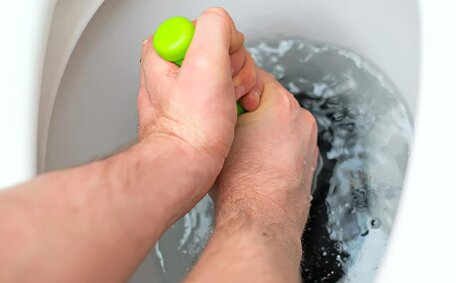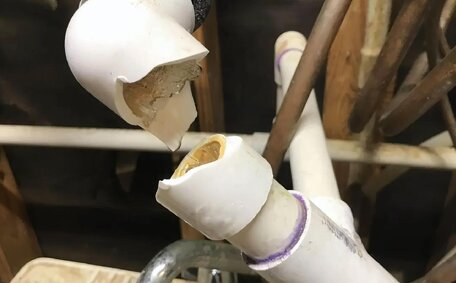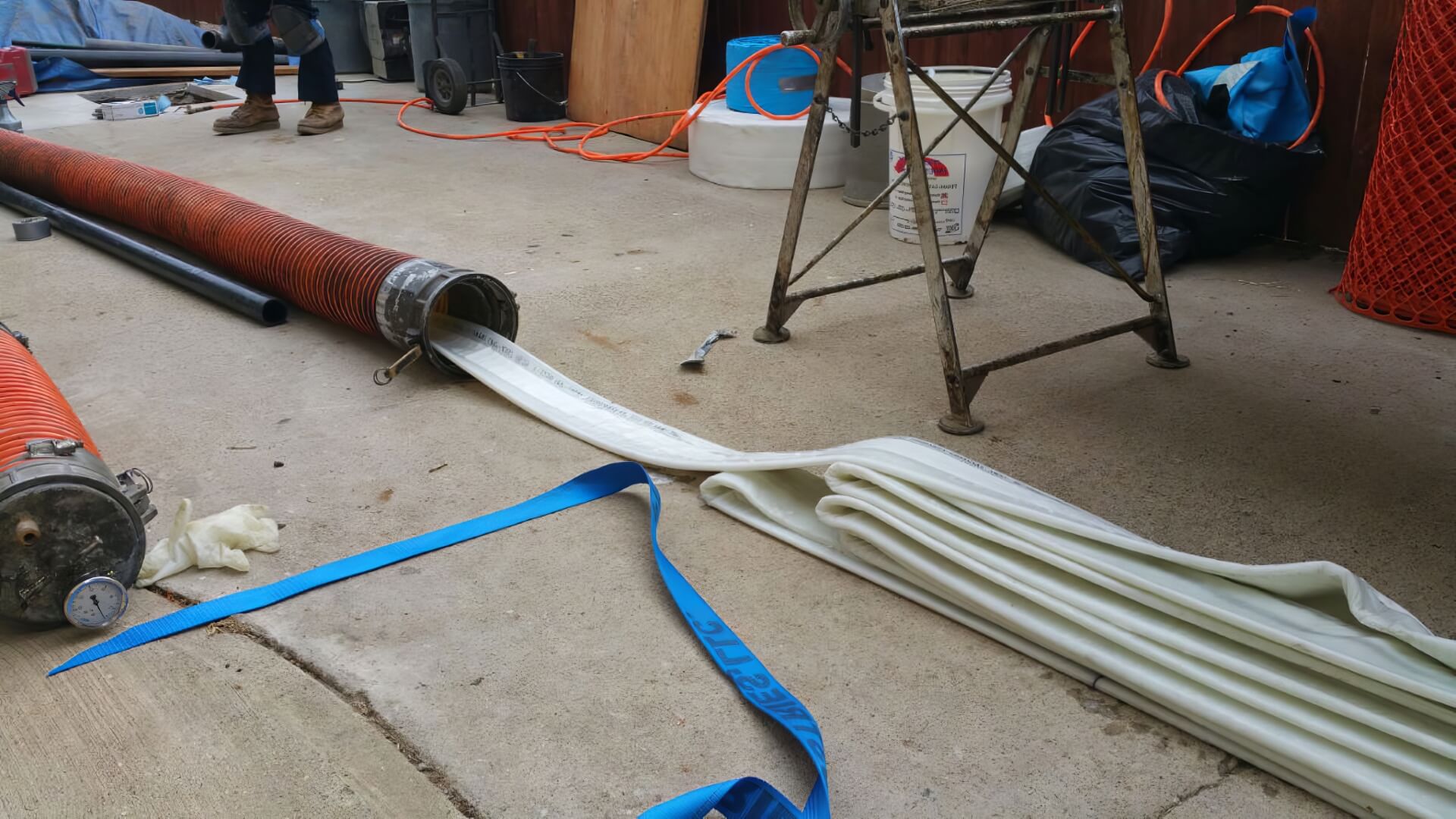What Causes Pipes to Bow or Become Misaligned
There are a few key factors that can lead to pipe bowing or misalignment over time:
- Ground movement - Shifting soil, earthquakes, and other ground disturbances can cause underground pipes to bend or move out of place.
- Temperature fluctuations - Expansion and contraction from seasonal or weather changes may warp pipes.
- Improper installation - If pipes aren’t properly supported or aligned during the initial install, they may bow or become misaligned.
These issues exert stress on pipe joints that can result in damaged pipes with cracks or leaks. Bowed pipes also have less flow capacity since the inside diameter is reduced. Additionally, drainage problems can occur if slopes or alignments are off.
Opt for our high-grade epoxy resin for pipe relining; engineered to endure heavy use for decades, it offers a durable solution by restoring flow and fortifying weakened pipes.
Can Pipe Relining Resolve Bowed or Misaligned Pipes?
Pipe relining effectively resolves issues with bowed or misaligned pipes in many situations. The pipe relining process involves inserting a resin-saturated pipe liner into the existing pipe. Once cured, the epoxy forms a new pipe within the old one, strong and effectively integrated for enhanced durability.
Suitable for an array of materials, pipe relining is a versatile solution for PVC, concrete, clay, and steel sewage pipes. Its effectiveness lies in providing internal structural support that restores flow capacity and realigns pipes. Pipe relining resolves misalignments at pipe joints and bends without the need for excavation.
There are some limitations though. Severely bowed or collapsed pipes that need to be dug up might lack the necessary space for a liner to be inserted without additional excavation. Additionally, pipes with complete breaks, detachments, or severe offsets over 50% of the diameter often require full replacement.
Overall, pipe relining is an established, less invasive option for repairing minor misalignments and deformities in pipes, saving time and money while offering greater convenience than traditional replacement. For severe damage, however, replacement or spot repairs may be necessary.
Advantages of Pipe Relining for Repairing Misalignments
Pipe relining offers several advantages over traditional repair methods, such as spot repairs or complete replacement:
- Less invasive – Without needing to be dug up, trenches or excavating flooring/walls, pipe relining is performed from the pipe inside out.
- Material Versatility – Applicable for a range of materials including PVC, concrete, clay, galvanised, and steel pipes.
- Long-lasting – High-grade epoxy resins carry out decades of structural reinforcement.
- Pipe Integrity – The relined pipe retains its structure, thereby maintaining the correct alignment and slope.
- Faster repairs – Cures in just hours with no extended downtime.
- Cost-effective – Saves on excavation, restoration, and labour expenses.
Limitations of Pipe Relining
While pipe relining is suitable for repairing many bowed and misaligned pipes, there are some limitations to be aware of:
- Severely collapsed or blocked drains may lack the necessary space for a liner to pass through or adhere, creating challenges for your drainage system.
- When pipes can no longer maintain their structural integrity due to complete breaks, detachments, or severe misalignments exceeding 50% of the diameter, they often require full replacement.
- Legal drainage regulations may require full pipe replacement in some cases.
- Clients with severely bowed pipes behind structures may consider alternative methods, such as pipe bursting.
A professional plumber, using a drain camera, will assess the severity of the pipe damage to determine if relining is viable or if replacement is required. They’re also knowledgeable about the current legal standards for drainage repairs.
When to Choose Pipe Relining Over Full Replacement
When weighing the advantages and limitations, pipe relining is often superior to complete replacement in scenarios where:
- Pipe damage is limited – Light bowing, small cracks, or minor misalignments are present.
- Excavation difficulties exist – Pipes are located under structures or behind walls.
- Importance of minimal downtime – Our plumbing services ensure that operations in homes, businesses, and critical infrastructures continue uninterrupted by offering swift relining solutions for leaking pipes.
- Disruption must be minimised – In inhabited buildings or densely populated areas.
- Original pipe layout needs preserving – For drainage alignments or slope integrity.
- Future access may be required – If additional repairs or modifications are foreseeable.
Typically, pipe relining is cost-effective compared to pipe replacement, with the durable epoxy materials also eliminating the need for future excavation. If you’re dealing with bowed or misaligned pipes, consult a professional pipe relining service to discuss your repair options.
The Pipe Relining Process Step-by-Step
The pipe relining process involves the following key steps:
- Inspection - A drain camera is used to thoroughly inspect the pipe, a crucial step in our comprehensive sewer pipe relining process. Measurements are taken to custom-fit the liner.
- Cleaning & Prep - High-pressure water jets clean the pipe, removing any protrusions or blockages to facilitate liner installation.
- Liner Installation - A resin-saturated felt liner is inserted into the pipe and inflated to fit all contours. The liner can be installed in precise sections, seamlessly fitting and rehabilitating the pipe.
- Curing - Hot water or steam is introduced, activating the epoxy resin to fully harden the liner. Cure times vary from 2-6 hours depending on pipe material and resin type used.
- Inspection & Finishing - Once cured, the pipe is re-inspected with a drain camera to validate water-tight sealing. Service connections are reinstated, restoring full functionality.
The seamless and continuous structure created within the existing pipe ensures many years of restored integrity. Relining from the pipe’s interior sidesteps excavation, reducing significant upheaval and reinstating flow efficiency in aged or impaired drains.
Longevity of Relined Pipes
Relined pipes exhibit longevity, with the restored pipe last often surpassing the expected lifespan of the original piping. High-grade epoxy resins used in the process are designed to endure decades of use.
The Nuflow pipe lining system projects a service life over 50 years for PVC pipes once installed by experts. For comparison, copper pipes generally last about 50 years and standard PVC piping around 35-40 years before replacement becomes necessary.
By reinforcing the inside of pipes without needing to replace entire sections, pipe relining provides superior longevity and avoids recurring leaks or failures. Pipe relining offers significant long-term cost savings by avoiding the need for frequent patching or full replacement of old pipes.
Since the structural resins conform precisely to the interior surface, relined pipes maintain flow efficiency. The smooth inner walls and realigned paths also improve drainage performance relative to the old pipes. This restores hydraulic capacity, further enhancing functional lifespan.
Pipe relining can remedy various issues from minor bows and cracks to significant damage, thereby extending the life of existing pipes or reinforcing weakened ones. Due to their extended lifespan, often surpassing property ownership terms, relined pipes represent a cost-efficient solution for the long haul.
Questions to Ask Your Plumber About Relining
When contemplating pipe relining, you should inquire about key details from your plumber to confirm it’s the appropriate remedy for your piping issues:
- What causes my pipe issues? - Understanding the root causes (e.g. tree roots, cracks, misalignments) will determine if relining can address them or if full replacement is necessary.
- What pipe materials do you service? - Check that your pipe types (e.g. clay, steel, PVC) are compatible with their relining process.
- Do you offer any pipe relining warranties? - Most providers offer guarantees on workmanship and materials, typically over 50+ years.
- How do you prepare and reline pipes? - Ask them to explain the full relining process start to finish.
- Duration of the project: - Repairs typically take 1-2 days to complete, without the need for substantial excavation or prolonged interruptions.
- How do you reconnect service lines? - Understand how lateral connections and taps are reinstated post-lining.
A thorough professional inspection and assessment is critical to determine the practicality of pipe relining. Give us a ring today on 1300 349 338 for professional advice or to schedule your on-site pipe relining assessment.
Castle Hill Plumbing, with extensive experience and state-of-the-art equipment, safely and effectively performs comprehensive pipe relining services.






